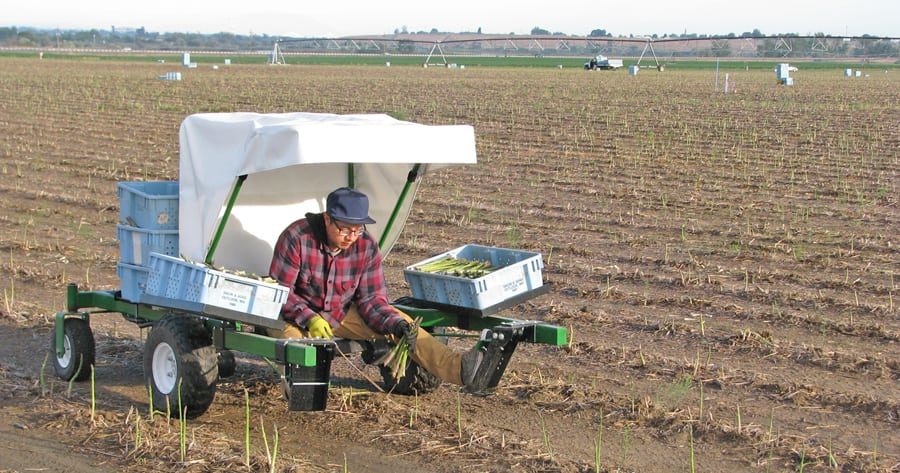
Home » Farmer buys motorized carts to help harvest labor-intensive crop
Farmer buys motorized carts to help harvest labor-intensive crop

June 15, 2017
Middleton Six Sons Farms bought 15 carts for its workers
The asparagus served at several Tri-City restaurants likely features spears picked by experts at Middleton Six Sons Farms who have worked in the fields for more than three decades.
It’s a lot of work to get the springtime favorite from field to plate.
That’s why the Middletons have invested in improved accommodations for their workers.
“The average age of our asparagus cutter is mid-50s,” said Keith Middleton, operations manager and co-owner of Middleton Farms with his parents, Bill and Cinda Middleton.
The farm, which has fields in Pasco and Burbank, grows 275 acres of green and purple asparagus, which require about 130 cutters to complete the annual harvest.
“Picking asparagus is one of the most physically demanding jobs there is because you’re constantly bending over,” he said. “That really affects people. In the orchard, people are standing straight up, which isn’t as hard on the body.”
The farm tried out a special motorized cart built for the first time last year called “The Mantis” in Ontario, Canada. It worked well, so the farm bought 15 carts for about $6,000 each for this year’s harvest.
He described the machine as a “motorized cart with ATV tires, kind of like a backwards go-cart, made specifically to harvest asparagus.”
The Mantis features trays on either side to hold bins. Operators control the cart with their feet, which leaves their hand free for cutting the spears.
“A lot of farmers want to be more efficient but I’m the next generation asparagus farmer and we’ve come to realize that these people are about as efficient as they can be. They’re skilled; one person cuts an average of 300 pounds of asparagus per day,” Middleton said.
Washington ranks third in the nation for producing the most asparagus, harvesting 3,400 acres last year valued at $18.6 million, according to the U.S. Department of Agriculture.
Efficiency aside, Middleton wants to motivate his workers to continue cutting while also encouraging younger generations.
“The idea is that a lot of these workers are getting older and the next generation is looking for something easier to do. Just like any career, once you get to a certain age, you don’t want to change careers. The asparagus cutters are no different,” Middleton said.
“They really do an excellent job and are very skilled, so if I can make it a little easier on their bodies, maybe it’ll extend the number of years they’re able to work,” he said.
He’s also looking to the future.
“The younger generation says, ‘I’m not going to walk and bend over all day long; driving that cart looks more appealing.’ I thought these (carts) might encourage the younger generations to cut asparagus,” Middleton said.
Worker Juan Fernandez appreciates the benefits of using the cart.
“It’s much nicer with the cart; I’m not as tired when I’m done working,” said Fernandez, who has cut asparagus for two years without the cart and one year with it.
The carts were used during harvest, which was expected to end in mid-June. Some of the “seasoned” workers were resistant to the change, Middleton said, just like people in other career fields.
“The carts were used on a voluntary basis. The workers needed to have the interest and believe the cart could make a positive difference, so we just let volunteers choose to use them in the fields,” Middleton said.
The outcome was mostly positive.
“The workers reported being less tired at the end of the day, but they were able to pick the same amount of asparagus in a day,” Middleton said. “There was a lot less strain on the back but the main complaint was that there was still some back pain due to being hunched over. The cutters needed to get out and stretch periodically,” understandable when a person stays in the same position for hours on end, he said.
In addition to lessening back pressure and the need for workers to be on their feet for hours, the Mantis boasts other benefits. Workers normally carry heavy bins laden with asparagus but The Mantis can shoulder this weight.
With asparagus harvest stretching from April to mid-June, workers face freezing early morning temperatures to excessive winds and blazing sun. The carts offer shade, protection from the wind and flying dust, to the farmworkers who labor from 3 to 9 a.m., seven days a week.
Though the carts are beneficial, they did have drawbacks this year.
“Half of them got used through the entire season, but one issue is they weren’t specifically built for my fields. They were too wide in our older fields,” Middleton said, which caused the tires to run over asparagus. “We’ll order about 15 more for next year with the correct spacing.”
The addition of the one-man machine has helped more than it has hindered, Middleton said.
“These carts aren’t the miracle machine by any means, but they’re a step in the right direction,” he said.
Local News Agriculture
KEYWORDS june 2017





